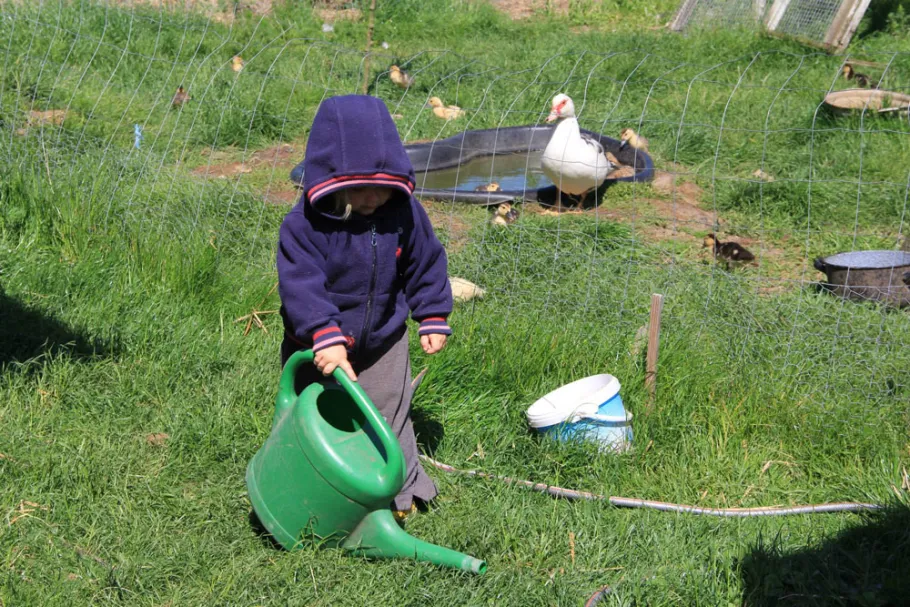
By Mihail Kossev
Permaculture is a design science that is accessible to all. It does not matter whether you have never in your life stepped in a garden or if you have grown up on a fruit farm. There is always something a student will learn from a permaculture course. It is somewhat important to optimize your lesson plan to the skill level of your students, but it is essential that you tailor your workshop to a specific age group. It is common knowledge that you would teach something differently to a child as you would to an adult.
Many say that age is just a number and in many ways that is true. Everyone matures at a different pace. Just like in a polyculture garden, not all fruits ripen at once. I have been astonished by the intellectual complexity of some toddlers as well as the sheer stupidity of many adults. Nonetheless, there are common patterns of social and physical development in the human species that a permaculture teacher should have in mind when designing a course.
The details of age are incredibly complex, so I will not bother naming numbers. Though for the purpose of clarity, I will organize learners into four general development groups, perhaps the way scientists do with all species in nature. Children, youths, adults and elderly. Below you will find some general guidelines that compares the different approaches.
TEACHING PERMACULTURE TO CHILDREN
Children are wild and free. Contrary to popular belief, they do not need structure for successful learning. They are inherent learners, it is genetically ingrained for that process to be accelerated in all species at that stage. Learning is a natural part of their brain-body function.
Kids live in Zone 5, so that is the best place to teach them. Teaching children how to garden is like trying to teach your cat how to use the toilet. It is possible, but very difficult. The most valuable start to permaculture you can provide for a child is a pleasant, fun and peaceful experience with Mother Nature.
Workshops for children need to be fun, tactile and free. You should try to steer clear of controlling their learning, since they know how to do it best themselves. People who think that teaching children is difficult are usually those who want to include an excess of structure to the lesson. Teaching children is actually quite easy if you have the energy for it.
At the early stages of human life, there is no desire or need for achievement. Let children be. Make sure that they are safe and that their natural openness to the outside world is put to good use.
TEACHING PERMACULTURE TO YOUTH
Once a person reaches puberty, their attention priorities change drastically. They recede into Zone 00. While still rapidly absorbent of the outside world, the most important thing for young adults to discover is themselves. Adolescent and early adulthood are prime moments in a life to develop and improve a vast diversity of skills. In the old times, once a person reached this stage of life, they became apprentices in a craft, usually within the family. In modern times, they put them in schools, many of which only focus on technical learning. Keep this mind when developing your lesson plans for youth. They are accustomed to the mainstream education format, but it would not hurt to complete the parts of which are missing.
Young adults need social time. Workshops should be geared towards team-building and character building. Self-evaluation should be at the end of each youth workshop. Individual achievement is important at that age, so even though doing practical work in groups is always good, you should value and use the time for them to develop their skills and knowledge on an individual level. Limit group practicals in time and effort. Allow more discussion and self-expression and less repetitive labor that would eventually exhaust their short attention spans. During your sessions, young adults can be overly concerned with other internal struggles common at that age. Give them space to be themselves. Youths are in a position in life where they are seeking role models. A good teacher should act as such.
Contrary to what many may assume, young adults are great listeners. Many of them are still biologically developing, which means that their brains are rapid sponges of information and experiences. Memories that are created at this age are remembered for their entire lives. In the big picture, if done right, this is the most effective time in a person’s life to receive a foundation of permaculture principles.
TEACHING PERMACULTURE TO ADULTS
There is a vast ocean of information all over the internet as well as work within the EPT partnership that discusses strategies for the adult learner. In many ways, permaculture education has focused most of its energy to teaching adults. This could be perhaps because of the time most people get into permaculture. Many of them are coming out of office jobs, or graduating university, and reworking their life paths.
Another reason that most of our resources on permaculture education are geared towards the adult learner is that this is the longest stage of life. We are only children for about a decade, then we enter the delicate period in between, and the come into adulthood somewhere in the early 20s. The differences are cultural, and in many ways, personal, though we remain adults for a good half-century, if we’re lucky.
Permaculture requires systems thinking. An adult, someone who has already a good amount of life experience behind then, can best grasp this approach because they have many reference points from their own lives already. An adult learner is not an empty cup. They come to the course with well-informed opinions and accomplishments already. Group work is very successful as well as extensive practicals. Rather than the individual accomplishment that are vital earlier in life, adults need to take their individual skills into a social context. Group accomplishments are essential to team-building in adult groups, where in teens, this unity can be achieved without much structure.
You can rely on adults to act with more responsibility than teens, but also expect them to be a bit more socially apprehensive. You should also expect them to be more self-aware than the two previous groups, which is beneficial in community, but it could be more difficult to “break the ice.”
I usually write all my lesson plans for adult learners since that is our biggest market, then adjust them in style and function when I am called to teach any of the other three groups. This way, you can safely pack it with a lot of facts and scientific information (something the adults just LOVE) and then use it as inspiration for something more playful for children, youth or elders.
TEACHING PERMACULTURE TO THE ELDERLY
Old age can be just as playful as childhood. Cross-pollinating both edges of the human generations is quite effective. Integrating a children’s workshop with elders participating will prove to be a very successful integration. Older people are more prone to be skeptical or defensive in the face of new information. They may also feel critical of the simplicity at which some permaculture basics and presented. You can avoid this by targeting your workshop to their children or grandchildren and including the elders as active participants. In all cases that I have done this, the elders become more engaged in the course material than they would have been if the information was aimed directly at them.
Older people already have establish habits and behaviour patterns. It is a waste of your energy to try to change them. It is like try to transplant a giant oak. A lot of energy, and what’s the point? If you are younger than your students, you have the opportunity to shift the focus to their experiences. Old age is a time for reflection, a time for processing the journey a person has taken. It is a time to celebrate your life and accomplishments. It is ineffective to impose radical ideas. The better approach is to create an environment of sharing.
- Log in to post comments
